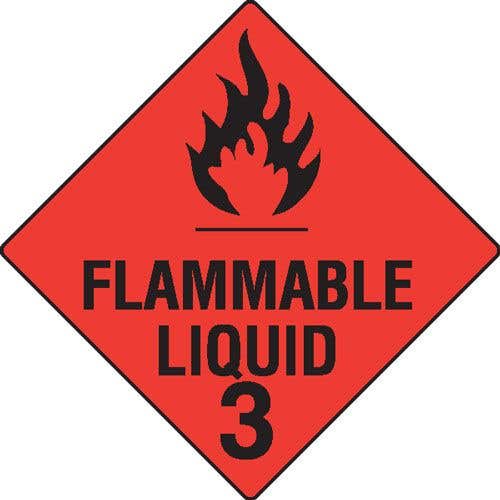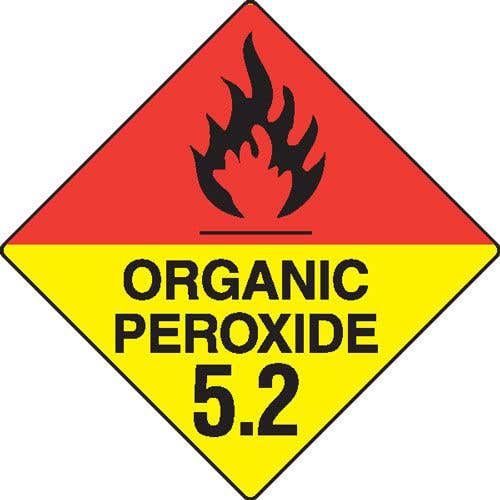Securing the safety of workers, bystanders and others where hazardous chemicals are concerned is extremely important.
DID YOU KNOW: Hazchem signs are required by Australian Law to be prominently displayed on any workplace, container or vehicle that stores certain chemical substances over a certain quantity. Hazchem signage is required for any businesses that either manufacture, handle, transport or store dangerous goods.
During an emergency situation, Hazchem signs and the subsequent labels are incredibly important - they allow emergency services to identify any chemicals present. For this reason, it is required for Australian businesses to correctly label all relevant items or chemicals using the appropriate Hazchem Signage. Improper or missing Hazchem signage and labels can lead to improper handling of dangerous goods, and can substantially increase the risk of workplace injury.
There is a range of different Hazchem classifications recognised in Australia, each with unique properties and hazardous specifications. This blog will unpack the nine broad classes of dangerous goods as classified by Worksafe Australia for transport purposes.
Class 1 - Explosives
- Indicates the storage and containment of Class 1 Explosive goods within a facility, vehicle or container etc.
- Class 1 explosives are any material or item that has the ability to rapidly conflagrate or detonate as a consequence of chemical reaction.
- Chemical examples: Ammunition, fireworks, flares and detonators.
- Recognisable by the orange background with black wording, exploding bomb symbol and the number '1'.
- Read Chapter 2.1 of the Australian Dangerous Goods Code for more information (latest edition - 7.6) – available here.
- To view the classification of Class 1 Explosives and the Regulations for transport by WorkSafe Australia, click here.
Class 2 - Gases
- Indicates the storage or containment of Class 2 Flammable Gases within a facility, vehicle or container etc.
- Class 2, Division 2.1 Flammable Gas is defined as Gases which, at 20 °C and a standard temperature of 101.3 kPa, are ignitable when in a mixture of 13% or less by volume in air.
- Chemical examples: Acetylene, Natural gas, and Liquified Petroleum Gas (LPG).
- Recognisable by a red background with black wording, flame symbol and the number '2'.
- Read Chapter 2.2 of the Australian Dangerous Goods Code for more information (latest edition - 7.6) – available here.
- Indicates the storage or containment of Class 2 Toxic Gases within a facility, vehicle or container etc.
- Class 2, Division 2.3 Toxic Gases are gases that are known to be or presumed to be toxic or corrosive to humans and thus pose a health threat.
- Chemical examples: Chlorine (compressed or liquefied), Anhydrous Ammonia (liquified), and Sulfur Dioxide (compressed or liquified).
- Recognisable by a white background with black wording, skull and crossbones symbol and the number '2'.
- Read Chapter 2.2 of the Australian Dangerous Goods Code for more information (latest edition - 7.6) – available here.
- Indicates the storage or containment of Class 2 Oxidising Gases within a facility, vehicle or container etc.
- Class 2 Oxidising Gases are those that, by providing oxygen can cause or contribute to the combustion of other materials.
- Chemical examples: Chlorine, nitrous oxide, oxygen, and compressed air.
- Recognisable by a yellow background with black wording, a circle below a flame symbol and the number '2'.
- Read Chapter 2.2 of the Australian Dangerous Goods Code for more information (latest edition - 7.6) – available here.
- Indicates the storage or containment of Class 2 Non-flammable, Non-toxic Gases within a facility, vehicle or container etc.
- Class 2, Division 2.2 non-flammable, non-toxic gases include gases that are asphyxiant, oxidising, or otherwise pure gas or gas mixes that are non-flammable and non-toxic.
- Chemical examples: Nitrogen (compressed or liquified), Carbon Dioxide (compressed or liquified), and Oxygen (compressed or liquified).
- Recognisable by a green background with black wording, gas cylinder symbol and the number '2'.
- Read Chapter 2.2.2.1(b) of the Australian Dangerous Goods Code for more information (latest edition - 7.6) – available here.
Class 3 - Flammable Liquids
- Indicates the storage or containment of Class 3 Flammable Liquids within a facility, vehicle or container etc.
- Class 3 Flammable Liquids are those that give off a flammable vapour when exposed to certain temperatures above the flashpoint.
- Chemical examples: Terpentine, Petrol, Diesel, and Kerosene.
- Recognisable by a red background with black wording, flame symbol and the number '3'.
- Application Example: Commonly used on warehouse forklift cylinders.
- Read Chapter 2.3 of the Australian Dangerous Goods Code for more information (latest edition - 7.6) – available here.
Class 4 - Other Flammable Substances
- Indicates the storage or containment of Class 4 Dangerous When Wet substances within a facility, vehicle or container etc.
- Class 4, Division 4.3 Dangerous When Wet materials are those that, on contact with water, are liable to become spontaneously flammable or exude flammable or toxic gas.
- Chemical examples: Aluminium phosphide, sodium, and zinc particles.
- Features a blue background with black wording, flame symbol and number '4'.
- Read Chapter 2.4 of the Australian Dangerous Goods Code for more information (latest edition - 7.6) – available here.
- Indicates the storage or containment of Class 4 Spontaneously Combustible Substances within a facility, vehicle or container etc.
- Class 4, division 4.2 Spontaneously Combustible substances are those that are liable to heating and spontaneously catching on fire under certain conditions.
- Chemical examples: Aluminium alkyls, and white phosphorus.
- Recognisable by a red and white split background with black wording, flame symbol and the number '4'.
- Read Chapter 2.4.3 of the Australian Dangerous Goods Code for more information (latest edition - 7.6) – available here.
- Indicates the storage or containment of Class 4 Flammable Solids within a facility, vehicle or container etc.
- Class 4 Flammable Solids are those that are spontaneously combustible under certain transport conditions or when in contact with water, emit flammable gasses.
- Chemical examples: Cerium, lutetium and neodymium.
- Recognisable by a red and white striped background with black wording, flame symbol and the number '4'.
- Read Chapter 2.4 of the Australian Dangerous Goods Code for more information (latest edition - 7.6) – available here.
Class 5 - Oxidising Substances & Organic Peroxides
- Indicates the storage or containment of Class 5 Oxidising Agents/Substances within a facility, vehicle or container etc.
- Class 5, Division 5.1, Oxidising Agents/Substances are substances that, under certain circumstances, may contribute to the combustion of other materials or substances.
- Chemical examples: Calcium hypochlorite (pool chlorine), Sodium nitrite, and Hydrogen peroxide (bleach).
- Recognisable by a yellow background with black wording, symbol and number '5.2'.
- Read Chapter 2.5.2 of the Australian Dangerous Goods Code for more information (latest edition - 7.6) – available here.
- Indicates the storage or containment of Class 5 Organic Peroxides within a facility, vehicle or container etc.
- Class 5, Division 5.2 Organic Peroxides are organic substances that are thermally unstable and may undergo exothermic self-accelerating decomposition.
- Properties of organic peroxides:
- Explosive decomposition;
- rapid burn rates;
- sensitivity to impact or friction;
- may damage eyes or skin upon contact, and;
- dangerous if combined with other substances. - Chemical examples: Benzoyl peroxide (plastics, fibreglass resin), and methyl ethyl ketone peroxide (MEKP).
- Recognisable by a red and yellow split background with black wording, a flame symbol and the number '5.2'.
- Read Chapter 2.5.3 of the Australian Dangerous Goods Code for more information (latest edition - 7.6) – available here.
Class 6 - Toxic & Infectious Substances
- Indicates the storage or containment of Class 6 Toxic Substances within a facility, vehicle or container etc.
- Class 6, Division 6.1 Toxic Substances are solid or liquid substances that are likely to cause death, severe injury or harm to human health if inhaled, swallowed, or upon contact with skin.
- Chemical examples: Formaldehyde, Cyanides, and Chloroform.
- Recognisable by a white background with black wording, representative skull and crossbones symbol and the number '6'.
- Read Chapter 2.6 of the Australian Dangerous Goods Code for more information (latest edition - 7.6) – available here.
- Indicates the storage or containment of Class 6 Infectious Substances within a facility, vehicle or container etc.
- Class 6, Division 6.2 Infectious Substances are substances containing pathogens that are likely to cause death or severe injury/harm to human health.
- Chemical examples: Goods containing pathogens such as bacteria, viruses, fungi, and prions.
- Recognisable by a white background with black wording, representative symbol and the number '6'.
- Read Chapter 2.6 of the Australian Dangerous Goods Code for more information (latest edition - 7.6) – available here.
Class 7 - Radioactive Material
- Radioactive Signs indicate the storage or containment of Class 7 Radioactive I, II or III substances within a facility, vehicle or container etc. (I pictured)
- Radioactive I substances are those containing very low radiation levels (0.5 mrem/hr.)
- Radioactive II substances are those containing relatively low radiation levels (>0.5 - 50 mrem/hr max on the surface).
- Radioactive III substances are those containing higher radiation levels (>50 - 200 mrem/hr max on the surface).
- Recognisable by a white background with black wording, black radioactive symbol and the red 'I', 'II' or "III'. II and III signs have yellow colouring on top.
- Provides space for and requires manual recording of 'Contents', 'Activity' and Transport Index'.
- Read Chapter 2.7 of the Australian Dangerous Goods Code for information on classification limits only (latest edition - 7.6) – available here.
- Note that the transportation of Class 7 Radioactive Materials is not wholly subject to the ADG Code.
Class 8 - Corrosive Sunstances
- Indicates the storage or containment of Class 8 Corrosive Substances within a facility, vehicle or container etc.
- Class 8 Corrosive Substances are those which, upon chemical action, will cause severe damage to living tissue, or will materially damage/destroy other goods or surroundings/transport.
- Chemical examples: Nitric acid, Mercury and Sodium hydroxide.
- White and black split background with black Corrosives pictogram and number '8'.
- Must be visibly displayed where class 8 corrosive substances are stored.
- Read Chapter 2.8 of the Australian Dangerous Goods Code for more information (latest edition - 7.6) – available here.
Class 9 - Miscelaneous & Environmentally Hazardous Substances
- Indicates the storage or containment of Class 9 Miscellaneous Dangerous Substances within a facility, vehicle or container etc.
- Class 9 Miscellaneous Dangerous Substances include all substances and articles that, when transported, pose a danger not covered by the other 8 dangerous goods classes.
- Chemical examples: Lithium batteries, Sulfur, and Asbestos.
- Also includes genetically modified, altered or other unnaturally occurring micro-organisms.
- Recognisable by a split black and white stripe over white background with black wording and the number '9'.
- Read Chapter 2.9 of the Australian Dangerous Goods Code for more information (latest edition - 7.6) – available here.
- Indicates the storage and containment of class 9 environmentally hazardous goods within a facility or container.
- Class 9 Environmentally Hazardous Substances include chemical substances that may pose a significant threat to the environment if inadequately handled and disposed of.
- Chemical examples: Carcinogens, Anthrax, and Asbestos.
- Recognisable by a white background with a black and white symbol to indicate the eco-hazard.
- Read Chapter 2.9 of the Australian Dangerous Goods Code for more information (latest edition - 7.6) – available here.





































































